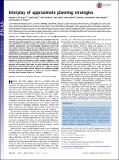| dc.contributor.author | Huys, Quentin J. M. | |
| dc.contributor.author | Faulkner, Paul | |
| dc.contributor.author | Eshel, Neir | |
| dc.contributor.author | Seifritz, Erich | |
| dc.contributor.author | Gershman, Samuel J. | |
| dc.contributor.author | Dayan, Peter | |
| dc.contributor.author | Roiser, Jonathan P. | |
| dc.contributor.author | Lally, Niall | |
| dc.date.accessioned | 2015-09-08T17:58:11Z | |
| dc.date.available | 2015-09-08T17:58:11Z | |
| dc.date.issued | 2015-03 | |
| dc.date.submitted | 2014-07 | |
| dc.identifier.issn | 0027-8424 | |
| dc.identifier.issn | 1091-6490 | |
| dc.identifier.uri | http://hdl.handle.net/1721.1/98405 | |
| dc.description.abstract | Humans routinely formulate plans in domains so complex that even the most powerful computers are taxed. To do so, they seem to avail themselves of many strategies and heuristics that efficiently simplify, approximate, and hierarchically decompose hard tasks into simpler subtasks. Theoretical and cognitive research has revealed several such strategies; however, little is known about their establishment, interaction, and efficiency. Here, we use model-based behavioral analysis to provide a detailed examination of the performance of human subjects in a moderately deep planning task. We find that subjects exploit the structure of the domain to establish subgoals in a way that achieves a nearly maximal reduction in the cost of computing values of choices, but then combine partial searches with greedy local steps to solve subtasks, and maladaptively prune the decision trees of subtasks in a reflexive manner upon encountering salient losses. Subjects come idiosyncratically to favor particular sequences of actions to achieve subgoals, creating novel complex actions or “options.” | en_US |
| dc.language.iso | en_US | |
| dc.publisher | National Academy of Sciences (U.S.) | en_US |
| dc.relation.isversionof | http://dx.doi.org/10.1073/pnas.1414219112 | en_US |
| dc.rights | Article is made available in accordance with the publisher's policy and may be subject to US copyright law. Please refer to the publisher's site for terms of use. | en_US |
| dc.source | National Academy of Sciences (U.S.) | en_US |
| dc.title | Interplay of approximate planning strategies | en_US |
| dc.type | Article | en_US |
| dc.identifier.citation | Huys, Quentin J. M., Niall Lally, Paul Faulkner, Neir Eshel, Erich Seifritz, Samuel J. Gershman, Peter Dayan, and Jonathan P. Roiser. “Interplay of Approximate Planning Strategies.” Proceedings of the National Academy of Sciences 112, no. 10 (March 10, 2015): 3098–3103. | en_US |
| dc.contributor.department | Massachusetts Institute of Technology. Department of Brain and Cognitive Sciences | en_US |
| dc.contributor.mitauthor | Gershman, Samuel J. | en_US |
| dc.relation.journal | Proceedings of the National Academy of Sciences | en_US |
| dc.eprint.version | Final published version | en_US |
| dc.type.uri | http://purl.org/eprint/type/JournalArticle | en_US |
| eprint.status | http://purl.org/eprint/status/PeerReviewed | en_US |
| dspace.orderedauthors | Huys, Quentin J. M.; Lally, Niall; Faulkner, Paul; Eshel, Neir; Seifritz, Erich; Gershman, Samuel J.; Dayan, Peter; Roiser, Jonathan P. | en_US |
| mit.license | PUBLISHER_POLICY | en_US |
| mit.metadata.status | Complete | |
